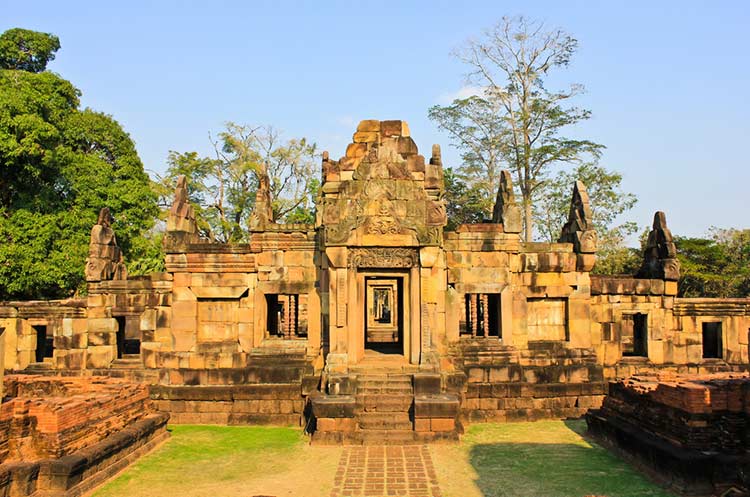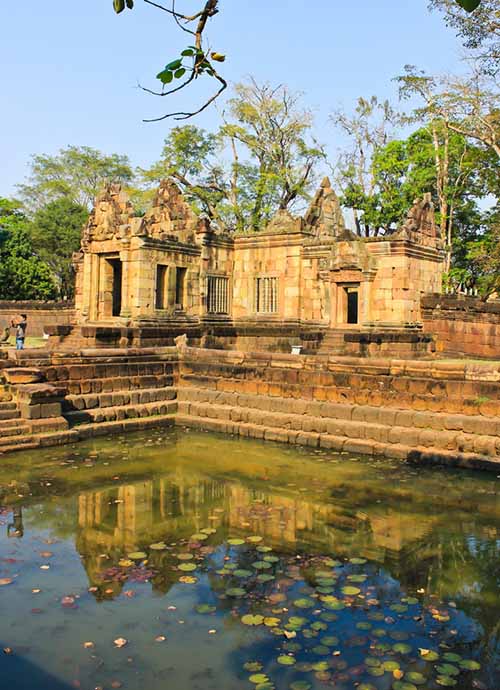Nice example of the Khmer architecture near to the Khao Phanum Rung ruins in Buriram. Well preserved and lesser frequented by tourists. A nice place to stop before going to the much larger Khao Phanum Rung site.

Muang Tum
Date
10th - 11th century
Location
Buriram
Muang Tum is a 1,000 years old Khmer temple complex in Buriram province in North East Thailand, not far from the border with Cambodia. The complex lies at the base of a mountain that is an extinct volcano. The full name of the temple is Prasat Hin Muang Tum, but is also called Muang Tam or Prasat Hin Muang Tam, with Prasat meaning palace or temple.
Muang Tum is located near the site of another better known Khmer complex, Phanom Rung that was built on top of the mountain.
Muang Tum is one of the temples built in Angkor style during a time when large parts of Thailand were controlled by the Khmer empire. It is situated on the ancient road from Angkor Thom (present day Siem Reap in Cambodia) to Phimai in Nakhon Ratchasima province, further North West.
The temple was created as a Hindu temple dedicated to Shiva. Muang Tum was built during the 10th and 11th century, about the same time its more famous neighbor was constructed, and it was abandoned after two or three centuries. Some very fine and well preserved example of Khmer architecture can be found at Muang Tum. This and the fact that the site is much quieter than its better known neighbor Phanom Rung makes it well worth a visit.
Muang Tum temple complex has a rectangular plan and is surrounded by a laterite wall. The center of each side of the wall contains a gate, the Eastern one being the main entrance. Once inside the complex you will find four ponds with steps leading to the bottom of the pond. The ponds are filled with beautiful colorful water lilies. Large five headed Naga snakes are placed at the corner of each pond.

The lintels over the gopuras contain 10 centuries old wonderfully carved high relief depictions of Shiva, Uma and other Hindu mythological figures, that are often in a very good condition.
The inner sanctuary contains five towers made from sand stone built on top of a low platform with the central one, which was the tallest has collapsed. This tower represents Mount Meru, the Hindu center of the universe and it contained a linga, a Hindu symbol representing the strength of Shiva. It is surrounded by four smaller towers. The inner sanctuary also contains a library, where the sacred Hindu scriptures were kept.
As Muang Tum is very close to Phanom Rung and is well preserved, it is well worth a visit, especially since it is usually quieter than its famous neighbor. The quiet setting as well as the large ponds create a serene and peaceful atmosphere.
From Buriram town you would have to take a local bus to either of the villages Nong Rong or Prakhon Chai, where you would have to taka a songthaew (converted pick up truck) or motorbike taxi.
A much more comfortable way would be to join an organized tour or hire a taxi for the day. Most hotels in Buriram should be able to book one, agree on the price before leaving.
Best time to visit is a weekday; on weekends and Thai public holidays the place can get busy with Thai tourists.
Adult
100
Child
100
If you plan to visit Phanom Rung as well, a 150 Baht ticket is valid for both sites.

Muang Tum
Well preserved Khmer temple
NameMuang Tum
Date
10th - 11th century
Location
Buriram
Muang Tum is a 1,000 years old Khmer temple complex in Buriram province in North East Thailand, not far from the border with Cambodia. The complex lies at the base of a mountain that is an extinct volcano. The full name of the temple is Prasat Hin Muang Tum, but is also called Muang Tam or Prasat Hin Muang Tam, with Prasat meaning palace or temple.
Muang Tum is located near the site of another better known Khmer complex, Phanom Rung that was built on top of the mountain.
Muang Tum is one of the temples built in Angkor style during a time when large parts of Thailand were controlled by the Khmer empire. It is situated on the ancient road from Angkor Thom (present day Siem Reap in Cambodia) to Phimai in Nakhon Ratchasima province, further North West.
The temple was created as a Hindu temple dedicated to Shiva. Muang Tum was built during the 10th and 11th century, about the same time its more famous neighbor was constructed, and it was abandoned after two or three centuries. Some very fine and well preserved example of Khmer architecture can be found at Muang Tum. This and the fact that the site is much quieter than its better known neighbor Phanom Rung makes it well worth a visit.
Structures of Muang Tum
Just North of Prasat Muang Tum is a lake or Baray, which measures more than a 1,000 meters long and 500 meters wide. The lake symbolizes the ocean that surrounds Mount Meru, the center of the universe in Hindu cosmology. It also served as a water reservoir.Muang Tum temple complex has a rectangular plan and is surrounded by a laterite wall. The center of each side of the wall contains a gate, the Eastern one being the main entrance. Once inside the complex you will find four ponds with steps leading to the bottom of the pond. The ponds are filled with beautiful colorful water lilies. Large five headed Naga snakes are placed at the corner of each pond.

The inner sanctuary
Broad walkways lead to the inner sanctuary enclosed by a rectangular gallery. At the center of each of the gallery walls an entrance gate or gopura leads to the inner sanctuary where Hindu ceremonies were held.The lintels over the gopuras contain 10 centuries old wonderfully carved high relief depictions of Shiva, Uma and other Hindu mythological figures, that are often in a very good condition.
The inner sanctuary contains five towers made from sand stone built on top of a low platform with the central one, which was the tallest has collapsed. This tower represents Mount Meru, the Hindu center of the universe and it contained a linga, a Hindu symbol representing the strength of Shiva. It is surrounded by four smaller towers. The inner sanctuary also contains a library, where the sacred Hindu scriptures were kept.
As Muang Tum is very close to Phanom Rung and is well preserved, it is well worth a visit, especially since it is usually quieter than its famous neighbor. The quiet setting as well as the large ponds create a serene and peaceful atmosphere.
How to get to Muang Tum
Muang Tam is located in the North Eastern province of Buriram, some 50 kilometers South of the provincial capital Buriram town and a few kilometers from Phanom Rung historical park. Getting to the site by public transport can be difficult.From Buriram town you would have to take a local bus to either of the villages Nong Rong or Prakhon Chai, where you would have to taka a songthaew (converted pick up truck) or motorbike taxi.
A much more comfortable way would be to join an organized tour or hire a taxi for the day. Most hotels in Buriram should be able to book one, agree on the price before leaving.
Opening hours
The temple complex is open daily from 6 am until 6 pm.Best time to visit is a weekday; on weekends and Thai public holidays the place can get busy with Thai tourists.
Entrance fee
Admission charged at the ticket booth is (Thai Baht):Adult
100
Child
100
If you plan to visit Phanom Rung as well, a 150 Baht ticket is valid for both sites.
https://www.renown-travel.com/khmertemples/muang-tum.html#:~:text=The full name of the temple is Prasat,that was built on top of the mountain.
Last edited:
